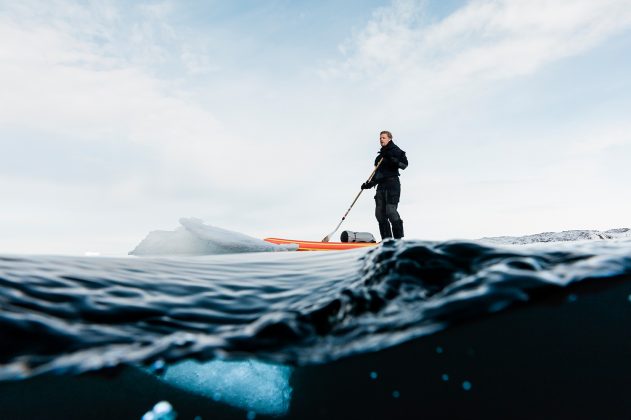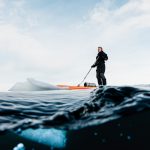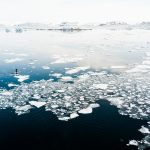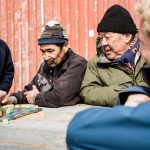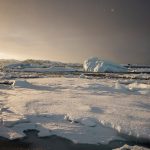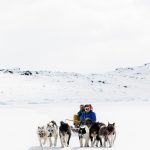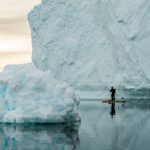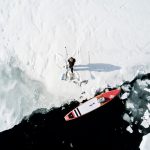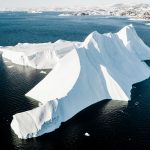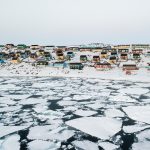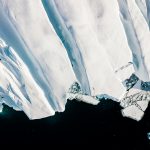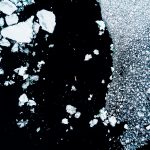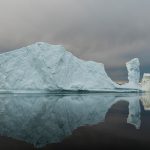GREENLAND
Words Michael Walther // Photos Daniell Bohnhoff
Data can only tell us so much. Environmental researcher Michael Walther wanted to make a more qualititave invesgitation into the effects of the anthroposcene on the remote west coast of Greenland. As he saw, climate change is altering not only the extent of the ice, but more crucially the way the ice behaves. The impact on the people that live there was profound.
I can see them in front of me. Rugged icebergs from centuries old ice. At the same time the silence, the sheer endlessness of the polar region. Not a soul far and wide, only nature and myself. I wouldn’t say that I generally don´t like to be amongst people, but I like this balance. It could be because I am originally from the small island of Norderney, that Greenland, as the world’s largest island, just magically attracts me. In May 2017 I came up with the idea, a year later, the implementation took place.
Together with my two friends Daniell Bohnhof and Max Stolarow I eventually enter Greenland in May 2018. The two accompany me to capture my tour with spectacular pictures and fascinating video recordings. My plan is to paddle along the coast with my stand up paddleboard to get a better impression of the climatic changes on site. But you can only recognize changes if you have a baseline reference. That´s why I wanted to get in direct contact with the local people there.
There are hardly any scientists who deny the human impact on climate change. The average temperatures are rising and the influence is already clearly visible, especially in the north of our planet. The so-called Ice Albedo effect is one reason for this. The ice pulls back, the protruding land and water surfaces reflect less sunlight into the atmosphere, which is where climate change accelerates. But what is the impact of rising temperatures in Greenland?
Aasiaat is the base for our journey. The small town with its 5,600 residents is located on the southern tip of Disco Bay. At this place life is on completely different course than we are used to in our latitudes. Going by car to the next village? No chance. The only ways to move in Greenland from place to place are planes, helicopters or boats. The population density on the on the largest island in the world is about 0.026 per square km, in Germany it’s about 232. So it is really very quiet here as we prepare our tour. Greenland delivers its first shock to us. Our escort boat is stuck in the ice at port, the driver is a prison guard in normal life and only has two days to spare and the whole port is still completely full of ice. A strong north-easterly wind has pushed the loose ice floes right into the bay off Assiaat, so it is unlikely that we will get out by boat or board in those conditions. We are frustrated and do not really know what to do next but getting upset does not help to melt the ice. Eventually the wind turns around. On the second day we have the opportunity to get started. Unfortunately, the wind didn’t finish the job and so the ice floes in the harbor are still not moving enough to clear the way. More hours pass and we sit in our room and wait. Sleep is out of the question. We are all too nervous. In addition, we wait for the call of our guide Martin. He checks all options to get out of the bay as fast as possible. We had wanted to be a few miles out in the Disco Bay by now, but wind, weather and ice conditions determine our planning.
So we double check the equipment again. I find out that I forgot the fin of my board at home in Kiel while packing and repacking all the equipment. When I tell Max and Daniell about my forgetfulness, they throw me a doubtful look. The two of them are obviously waiting for the resolution of the bad joke, which unfortunately I don´t have. Let’s consider the options quickly. The consideration is short: finding a surf shop in Greenland is impossible and so I have no other choice than shaping a fin with my multitool from a plastic chopping board. I then attached it with a simple Spax screw in the fin box of the board. I will find out later that this construction is not really reliable.
Finally, we get the long-awaited call. Martin has an idea and has already prepared the dogs. I won’t paddle the first few kilometers, but will go via dog sled instead. Martin takes me by sledge to the end of the ice and goes back to go with Max and Daniell by boat. Okay, looks like I’ll be starting alone. I’m actually don’t mind that but the ice floes are constantly moving so I feel really queasy. Slowly, I’m forging ahead and finally I hear the sound of Martin’s boat. Faster than expected, he made it out of the harbor. At last I am paddling out in the bay.
After a few kilometers, I notice some ripples on the water. Unfortunately, the wind has started again. The ice floes start to drift. I paddle through a small channel between the floes and before I know it, it closes shut in front of the escort boat. Our paths quickly split and we’re zigzagging between floating ice floes. If the boat can’t get any further, the team will have to find another way. I get stuck and grab the board to jump from ice floe to ice floe. It somehow reminds me of a computer game, but it’s only half as funny. Before I arrive on an ice floe, I do not know if it will hold my weight. Of course, I have my board with me, which will always keep me afloat.
I’m also wearing my special survival suit from Secumar, which normally serves the sea rescuers or naval aviators. Still, this situation is very uncomfortable. The water is just above freezing and the air is minus 15 degrees. Under this kind of conditions, I would like to avoid a swim in the Polar Sea. But the wind gets stronger and the floes drift more and more. Slowly they pile up and threaten to completely close the bay again. We decide to pack myself and my board on the boat and quickly approach the next town. Safety first, especially in these regions.
Although we had planned some short stops, I hadn’t thought that the paddling would be exhausting. Because of the interruptions of the ice floes and the short sprints to get through the gaps quickly, my energy was fast disappearing. This first stop is most welcome. In just 12 hours the wind is supposed to settle and turn slightly, giving us time for
regeneration. But we are happy.
We chat with a few fishermen who are playing a mill game with hand-carved figures, it looks like they play it very often. I have no chance and even Max, who at least remembers the rules a little bit loses round after round, very much to the delight of the locals. It’s good that we can break the ice easily with the residents. We quickly get into a conversation and the hunters and fishermen tell us their observations.
Only a few speak English and my Danish is about as good as my Greenlandic. Thanks to our guide Martin, who translates everything for us, we get into a lively conversation. The Greenlanders are very sensitive to nature and its changes. Their whole life and survival is associated with this. Valdemar Petersen is an 84-year-old hunter with whom we get into conversation here. Using old images and noisy Super 8 videos, Valdemar helps us understand how nature and ice have changed. The transition times with brittle ice are getting longer. In winter, the Greenlanders hunt by dog sled, in summer by boat. Both are barely possible nowadays. The winter ice only carries for a short time and in the summer large ice bergs drift through the bay, which should be connected further to the north with the other summer ice. Precisely in this way we were also affected the last days and so we can well feel how uncomfortable it must be, if your own hunting depends on it. Because here nobody chases for fun, this is about the real survival. Everything that the Greenlanders can´t hunt, they have to compensate for by shopping in expensive supermarkets.
After a few hours we say goodbye to Valdemar with a heavy heart and move on. Slowly we work our way direction north. Breaks on the boat that accompanies me are included. As the SUP board is too big for this, my team keeps putting me out on ice floes, so I can pump up my board there, when we carry on. Standing in the middle of the Polar Sea on an ice floe and pumping up an inflatable is a strange feeling.
Although according to Valdemar, temperatures were between -20 and -30 degrees in the past, I admit that the current -15 degrees putting me on my limits. The water does not run off my board, but freezes on top of it. That makes it slippery and as soon as I want to change my stand position minimally, I slide away. Spikes would be the solution, but not with an inflatable board. I have no choice but to simply stay in the position that I chose in the morning. In addition, I lose my home-made fin several times. Luckily, my provisional floats. Nevertheless, the loss of the fin means every time that I have to turn around and look for it in the water. Taking the gloves off again, grab in the ice-cold water, paddle on an ice floe and fix the fin again. I eventually try some fine tuning with my multitool and carve a few millimeters around it. It works better now, it looks like I found a good position for the screw. Under these annoying concomitant circumstances, we slowly move direction north. Short naps in the companion boat or in small coastal dwellings interrupt the tour. Miles and miles I work my way forward, sometimes sitting on the boat where the ice is breaking up too fast. We have to take long detours if a closed area makes our direct route impossible. Again and again Max sends his drone up to film but also to see which way is still open.
After four days we finally can see the first fragments of the Sermeq Kujalleq glacier appear on the horizon. It´s located slightly south of Ilulissat and belongs to the World Natural Heritage of UNESCO since 2004. The glacier tongue flows into the bay at a rate of 20 meters a day. Even the fragments are impressive and clearly show the huge forces working here. Paddle stroke after paddle stroke we continue along the ice mountains, heading north.
My paddling goal for trip was to reach the border where the open sea turns to closed ice. The fact that this ice limit is not a fixed location poses problems. Depending on the wind direction, the ice moves around and makes life difficult for the local people to navigate. This tour had revealed much about climate change and the life of the Greenlanders. And we were suffering from the changing conditions. After covering about 200 kilometers with ice on the board, cold fingers, snow in the face, moments of terror next to icebergs and many detours we reached the closed ice cover in front of Ilulissat. Here, we could get no closer to the glacier without risking our lives. Even for our guide Martin, it is too risky to predict when and if a glacier will calve.
Tired, broken and exhausted from the tension of the last days, we reach Ilulissat, the small town on the eastern shore of Disco Bay. We gained a lot from this special paddling tour. Amazing impressions, important information and contacts to people we will never forget again. Even if I had to enter the water by dog sled sometimes, on a good stand up paddling tour almost no challenge is unsurmountable. In Ilulissat this special journey with all its strange and fascinating sensations ends. I’ll probably always remember what it feels like to paddle alone, in the utter silence of Arctic nature, with a small board between ice floes and icebergs.” SUP International

